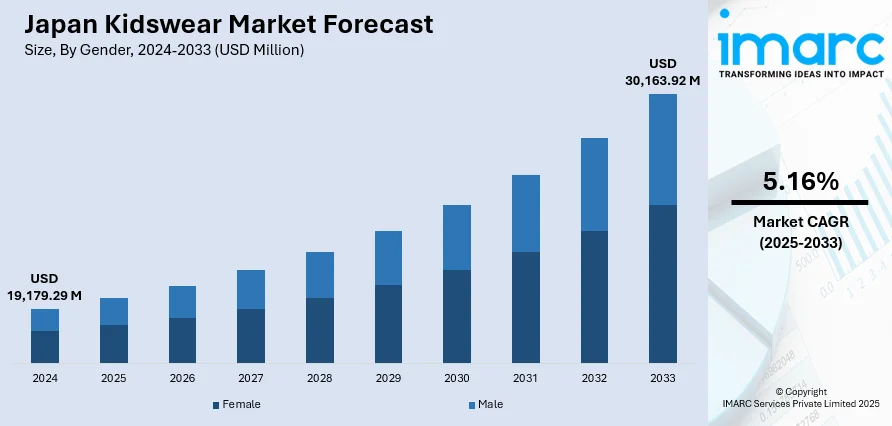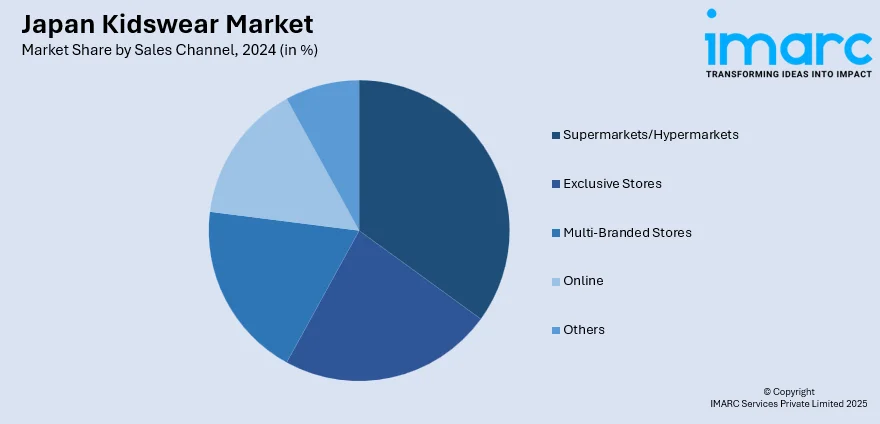
Japan Kidswear Market Size, Share, Trends and Forecast by Gender, Category, Season, Sector, Sales Channel, and Region, 2025-2033
Japan Kidswear Market Overview:
The Japan kidswear market size reached USD 19,179.29 Million in 2024. Looking forward, IMARC Group expects the market to reach USD 30,163.92 Million by 2033, exhibiting a growth rate (CAGR) of 5.16% during 2025-2033. The market is thriving due to strong demand for high-quality, stylish, and comfortable clothing tailored to children’s needs. Parents prioritizing premium fabrics, innovative designs, and functional wear and the popularity of character-themed apparel and seasonal collections are also boosting product sales. Growth of online shopping further enhances accessibility and variety, positively influencing the Japan kidswear market share.
|
Report Attribute
|
Key Statistics
|
|---|---|
|
Base Year
|
2024
|
|
Forecast Years
|
2025-2033
|
|
Historical Years
|
2019-2024
|
| Market Size in 2024 | USD 19,179.29 Million |
| Market Forecast in 2033 | USD 30,163.92 Million |
| Market Growth Rate 2025-2033 | 5.16% |
Japan Kidswear Market Trends:
Emphasis on Quality and Functionality
Japanese consumers, especially parents, place a high value on quality and durability when purchasing clothing for children. In Japan, kids’ clothing is expected to endure playful activities and still keep its comfort and style. This makes brands work towards using luxury materials, applying care and attention to stitching, and creating designs with convenient features like easy-care and adjustable fits. Parents tend to like clothing that adjusts to the weather and helps with school and extracurricular activities. Flame-resistant materials and the use of non-poisonous dyes are also welcomed by parents. Because of this approach, people tend to remain loyal to the brand and purchase from it again. As consumer expectations rise, the emphasis on superior craftsmanship and child-friendly design continues to play a key role in driving the Japan kidswear market growth.

To get more information on this market, Request Sample
Influence of Pop Culture and Character Licensing
Pop culture and animated characters significantly impact children’s fashion preferences in Japan. Popular anime, manga, and character franchises such as Hello Kitty, Pokémon, and Anpanman drive the popularity of licensed apparel. These character-themed clothes are often tied to seasonal collections, product collaborations, and media promotions, creating strong emotional connections with both children and parents. Retailers and brands capitalize on this trend by frequently updating designs and launching exclusive or limited-edition items. This dynamic environment encourages high turnover and frequent purchases, especially during holidays or school seasons. The integration of pop culture into fashion not only fuels excitement in the market but also keeps collections fresh and in high demand, contributing meaningfully to the sustained growth of the Japan kidswear market.
Rising Interest in Sustainable and Ethical Fashion
Sustainability has become a strong purchasing factor for many Japanese parents who are concerned about environmental impact and ethical production. There is growing demand for kidswear made from organic, recycled, or biodegradable materials, as well as transparency in sourcing and manufacturing practices. Eco-friendly packaging and clothes with certifications like GOTS (Global Organic Textile Standard) are gaining traction. Parents are increasingly willing to invest in fewer, higher-quality garments that are both durable and ethically produced. Brands that embrace circular economy principles, such as take-back programs or upcycling initiatives, are especially appealing. This shift toward conscious consumerism is not only helping the environment but also positioning responsible brands more favorably in the eyes of discerning shoppers, thus fueling growth in the Japan kidswear market.
Japan Kidswear Market Segmentation:
IMARC Group provides an analysis of the key trends in each segment of the market, along with forecasts at the country and regional levels for 2025-2033. Our report has categorized the market based on gender, category, season, sector, and sales channel.
Gender Insights:
- Female
- Male
The report has provided a detailed breakup and analysis of the market based on gender. This includes female and male.
Category Insights:
- Uniforms
- T-Shirts/Shirts
- Bottom Wear
- Ethnic Wear
- Dresses
- Denims
- Others
A detailed breakup and analysis of the market based on the category have also been provided in the report. This includes uniforms, t-shirts/shirts, bottom wear, ethnic wear, dresses, denims, and others.
Season Insights:
- Summer Wear
- Winter Wear
- All Season Wear
A detailed breakup and analysis of the market based on the season have also been provided in the report. This includes summer wear, winter wear, and all season wear.
Sector Insights:
- Organized Sector
- Unorganized Sector
A detailed breakup and analysis of the market based on the sector have also been provided in the report. This includes organized sector and unorganized sector.
Sales Channel Insights:

- Supermarkets/Hypermarkets
- Exclusive Stores
- Multi-Branded Stores
- Online
- Others
A detailed breakup and analysis of the market based on the sales channel have also been provided in the report. This includes supermarkets/hypermarkets, exclusive stores, multi-branded stores, online, and others.
Regional Insights:
- Kanto Region
- Kansai/Kinki Region
- Central/ Chubu Region
- Kyushu-Okinawa Region
- Tohoku Region
- Chugoku Region
- Hokkaido Region
- Shikoku Region
The report has also provided a comprehensive analysis of all the major regional markets, which include the Kanto Region, Kansai/Kinki Region, Central/ Chubu Region, Kyushu-Okinawa Region, Tohoku Region, Chugoku Region, Hokkaido Region, and Shikoku Region.
Competitive Landscape:
The market research report has also provided a comprehensive analysis of the competitive landscape. Competitive analysis such as market structure, key player positioning, top winning strategies, competitive dashboard, and company evaluation quadrant has been covered in the report. Also, detailed profiles of all major companies have been provided.
Japan Kidswear Market News:
- In May 2024, the top Inditex brand incorporated Japanese design elements into its kids' clothing. Following the debut of its 'Timelesz' collection, Zara expanded its kids' business by launching a new line of "jinbei." Reminiscent of a kimono, this traditional Japanese summer dress is made especially for kids.
- In January 2024, Japanese casualwear giant Uniqlo signed children's entertainment business Moonbug to a similar deal after the two companies worked together on a CoComelon co-branded kidswear line in November.
Japan Kidswear Market Report Coverage:
| Report Features | Details |
|---|---|
| Base Year of the Analysis | 2024 |
| Historical Period | 2019-2024 |
| Forecast Period | 2025-2033 |
| Units | Million USD |
| Scope of the Report |
Exploration of Historical Trends and Market Outlook, Industry Catalysts and Challenges, Segment-Wise Historical and Future Market Assessment:
|
| Genders Covered | Female, Male |
| Categories Covered | Uniforms, T-Shirts/Shirts, Bottom Wear, Ethnic Wear, Dresses, Denims, Others |
| Seasons Covered | Summer Wear, Winter Wear, All Season Wear |
| Sectors Covered | Organized Sector, Unorganized Sector |
| Sales Channels Covered | Supermarkets/Hypermarkets, Exclusive Stores, Multi-Branded Stores, Online, Others |
| Regions Covered | Kanto Region, Kansai/Kinki Region, Central/ Chubu Region, Kyushu-Okinawa Region, Tohoku Region, Chugoku Region, Hokkaido Region, Shikoku Region |
| Customization Scope | 10% Free Customization |
| Post-Sale Analyst Support | 10-12 Weeks |
| Delivery Format | PDF and Excel through Email (We can also provide the editable version of the report in PPT/Word format on special request) |
Key Questions Answered in This Report:
- How has the Japan kidswear market performed so far and how will it perform in the coming years?
- What is the breakup of the Japan kidswear market on the basis of gender?
- What is the breakup of the Japan kidswear market on the basis of category?
- What is the breakup of the Japan kidswear market on the basis of season?
- What is the breakup of the Japan kidswear market on the basis of sector?
- What is the breakup of the Japan kidswear market on the basis of sales channel?
- What is the breakup of the Japan kidswear market on the basis of region?
- What are the various stages in the value chain of the Japan kidswear market?
- What are the key driving factors and challenges in the Japan kidswear market?
- What is the structure of the Japan kidswear market and who are the key players?
- What is the degree of competition in the Japan kidswear market?
Key Benefits for Stakeholders:
- IMARC’s industry report offers a comprehensive quantitative analysis of various market segments, historical and current market trends, market forecasts, and dynamics of the Japan kidswear market from 2019-2033.
- The research report provides the latest information on the market drivers, challenges, and opportunities in the Japan kidswear market.
- Porter's five forces analysis assist stakeholders in assessing the impact of new entrants, competitive rivalry, supplier power, buyer power, and the threat of substitution. It helps stakeholders to analyze the level of competition within the Japan kidswear industry and its attractiveness.
- Competitive landscape allows stakeholders to understand their competitive environment and provides an insight into the current positions of key players in the market.
Need more help?
- Speak to our experienced analysts for insights on the current market scenarios.
- Include additional segments and countries to customize the report as per your requirement.
- Gain an unparalleled competitive advantage in your domain by understanding how to utilize the report and positively impacting your operations and revenue.
- For further assistance, please connect with our analysts.
 Request Customization
Request Customization
 Speak to an Analyst
Speak to an Analyst
 Request Brochure
Request Brochure
 Inquire Before Buying
Inquire Before Buying




.webp)




.webp)












